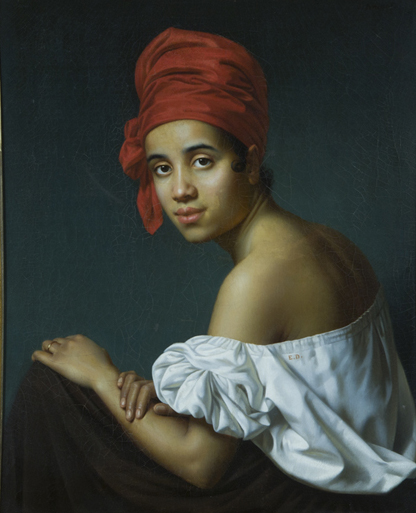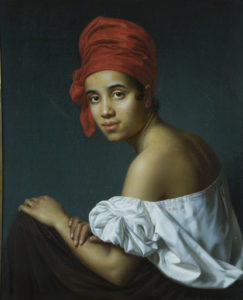Creoles
The term "Creole" has long generated confusion and controversy. The word invites debate because it possesses several meanings, some of which concern the innately sensitive subjects of race and ethnicity.

Courtesy of The Historic New Orleans Collection
Creole in a Red Headdress. Amans, Jacques Guillaume Lucien (Artist)
The term “Creole” has long generated confusion and controversy. The word invites debate because it possesses several meanings, some of which concern the innately sensitive subjects of race and ethnicity. In its broadest sense, Creole means “native”—or, in the context of Louisiana history, “native to Louisiana.” In a narrower sense, however, it has historically referred to people of African, European, and/or mixed African, European, and Indigenous ancestry who are native to Louisiana. As such, the word “Creole” can refer to persons who are Black, white, or multi-racial, with Creole ethnicity regarded by some as independent of skin color. In short, the word means different things to different people, and more than one ethnic or racial group has a claim to the term.
The word Creole derives from the Latin creare, meaning “to beget” or “to create.” It appears to have been used first by the Portuguese in the form crioulo, which denoted an enslaved person born in the New World (as opposed to one born in Africa). By the 1600s, crioulo came to denote people of European and/or African heritage born in the Americas. In Louisiana, the term—which evolved into criollo in Spanish and créole in French—adhered to this convention.
Eighteenth-Century Creoles
In the eighteenth century the term “Creole” references individuals born in Louisiana in a variety of documents, including official correspondence as well as sacramental, notarial, and judicial records. By the end of the century, Louisiana was home to a sizable population of free people of color, many of whom were of both European and African ancestry. In 1791 they made up 27 percent of the free population and 17 percent of the total population living in the colonial capital of New Orleans. These Creoles of color, known most commonly as les gens de couleur libres, occupied a middle ground between free white colonists and enslaved people of African descent. They commonly owned property (sometimes including slaves), participated in local militias, and received formal educations.
Nineteenth-Century Creoles
In the antebellum nineteenth century, people of European and African ancestry born in Louisiana continued to use “Creole” in reference to themselves, though increasingly the term distinguished those persons born in Louisiana from Anglo-American newcomers and European immigrants who arrived after the Louisiana Purchase in 1803. But with the coming of the Civil War, the end of slavery, and the subsequent collapse of the South’s economy, white Louisianans gradually took away the privileged status that set Creoles of color apart from formerly enslaved Black Creoles. By the 1890s, no middle ground remained for Creoles of color. As one historian has observed, Creoles of color “were left with nothing but their sense of group identity and a nostalgia for halcyon times.” Although they now occupied the same social stratum as formerly enslaved people, Creoles of color continued to hold themselves apart as distinct. They did so, for example, through the practice of endogamy (marriage within the ethnic group).
Many white people in antebellum Louisiana also referred to themselves as Creoles. Among people of European descent, the term generally referred to persons of upper-class French or Spanish ancestry, and even German ancestry (though all eventually spoke French as their primary language). The term has even been applied to persons of Italian ancestry in New Orleans. Indeed, many white Creoles could be found in New Orleans, as well as in parishes such as Avoyelles and Evangeline, which, while incorrectly regarded today as historically Acadian, were actually populated by white Creoles. Politically, Louisiana’s aristocratic white Creoles stood in contrast to the more democratic américains who flooded the state after the Louisiana Purchase. For example, white Creoles in the early nineteenth century used their influence in state government to grant voting rights only to males who paid taxes and owned property, thereby denying the vote to many poor white males. Like the Creoles of color, white Creoles experienced dramatic economic decline after the Civil War. While some managed to retain their sense of identity, many white Creoles—particularly in rural and small-town southern Louisiana—began to intermarry with the region’s large Acadian population.
This intermarriage among white Creoles and Acadians marked a major shift in southern Louisiana’s cultural landscape, for white Creoles had previously disdained the Acadians for their poverty. Once they occupied the same economic level, however, intermarriage between the two groups became more acceptable. The white Creoles and Acadians coalesced into a new ethnic group, the Cajuns. As a result, many surnames of French Creole (Soileau, Fontenot, and François), Spanish Creole (Dartez, Miguez, Romero), and German Creole (Hoffpauir, Hymel, and Stelly) origin are now widely considered Cajun. Still, as historian Carl A. Brasseaux noted, “A great deal of confusion regarding this group existed among outsiders, who in postbellum times sometimes labeled them Creoles, sometimes Cajuns. But by 1900, Américains . . . had succeeded in permanently affixing the Cajun identity to [all] poor Francophones”—including poor white Creoles.
Contemporary Creoles
Although some white southern Louisianans reject the Cajun label and continue to call themselves Creoles, the term is used today most commonly in reference to those of full or partial African heritage. Like their ancestors, these Creoles are typically French-speaking and Catholic (distinguishing them from other Louisianans of African heritage who derive from English-speaking, Protestant heritage). Significant populations of these Creoles can be found in New Orleans, the Acadiana region of southern Louisiana, the Cane River/Isle Brevelle area near Natchitoches, and in East Texas as far west as Houston. Moreover, a notable population of Creoles of African descent exists in California, the result of decades of departures during the Great Migration to growing Creole enclaves in places such as Oakland and San Francisco.
Increasingly, however, Creoles of African ancestry—regardless of the pre-Civil War status of their ancestors (e.g. enslaved or free)—have put aside old animosities based largely on skin color and social standing to work for mutual preservation. They often describe themselves simply as Creoles, despite past criticism from Afrocentric groups like the Un-Cajun Committee of Lafayette, which once called on Creoles of African descent to reject their Creole identity and refer to themselves solely as African Americans. Regardless, numerous groups support the study and preservation of Creole heritage, including Lafayette’s C.R.E.O.L.E., Inc. (Cultural Resourceful Educational Opportunities toward Linguistic Enrichment, established in 1982), whose adopted flag reflects the West African origins of both Creoles of color and Black Creoles; Natchitoches’s Creole Heritage Center (established at Northwestern State University in 1998); and New Orleans’s Louisiana Creole Research Association (LA Creole, established in 2004) and Creole Genealogical and Historical Association, Inc. (Creole Gen, established in 2012).
White Creoles have increasingly joined with Creoles of African descent to preserve and promote their similar Louisiana heritage. For example, they have combined efforts to speak out when Creole culture is misrepresented as “Cajun,” even as some of them assert that Cajuns are in fact a type of Creole. (Cajuns are, after all, Louisiana natives of French-speaking, Roman Catholic heritage — which fits the broad definition of a Creole. It remains to be seen whether the mass of Cajuns will warm to this notion.)
In addition to serving as an ethnic label, the word Creole has been applied to a variety of objects produced in Louisiana, such as Creole ponies, Creole onions, and Creole tomatoes. The word is frequently used today in reference to architecture and cuisine. Creole cooking is strongly associated with New Orleans, where the term suggests urbane, multicourse dining, as opposed to Cajun cooking, which is associated with rural or small-town fare centered around a single course. This, however, can be misleading, because rural and small-town Creoles in South Louisiana have their own culinary traditions, and these often blur the line between Cajun and Creole fare. Indeed, outside of New Orleans, there often is little or no difference between Cajun and Creole cuisine, except perhaps the ethnicity of the preparer.
Moreover, there is Creole music, from Afro-Caribbean-inspired folksongs of antebellum Congo Square to the more modern, bluesy, accordion-based zydeco of rural and small-town southwestern Louisiana (typified by songs like “Les Haricots Sont Pas Salés”). In addition, the Creole language continues to be used in Louisiana, and in recent decades it has received more attention from linguists and language-preservation organizations. These scholars generally regard Creole not as a dialect of French but rather as an “autonomous language” because of “major differences in grammatical structure.” As such the language today is less commonly referred to as “Creole French,” which implies it is a dialect of continental French, in favor of “Creole,” “Kreyòl,” or “Kouri-Vini.”
In 1998 Albert Valdman of Indiana University issued the Dictionary of Louisiana Creole, and in 2010 he teamed with several Louisiana scholars to publish the Dictionary of Louisiana French: As Spoken in Cajun, Creole, and American Indian Communities. During the same period, the state-chartered Council for Development of French in Louisiana (CODOFIL), which long overlooked Creole in favor of continental French and even Cajun French, began to include the language in its preservation efforts. In fact, CODOFIL now publishes its official web site in French, English, and Kreyòl (Creole). Similarly, in 2008, Festivals Acadiens, one of South Louisiana’s premier folk festivals, changed its name to Festivals Acadiens et Créoles to more accurately reflect the cultural contributions that had always been key to the festival’s identity.
